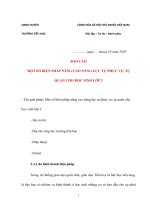Cambridge international AS a level chemistry coursebook with digital access (2 years) by lawrie ryan, roger norris (rachidscience)
Bạn đang xem bản rút gọn của tài liệu. Xem và tải ngay bản đầy đủ của tài liệu tại đây (35.83 MB, 886 trang )
Chemistry
forCambridgeInternationalAS&ALevel
COURSEBOOK
LawrieRyan&RogerNorris
Teachersplayanimportantpartinshapingfutures.Our
DedicatedTeacherAwardsrecognisethehardworkthat
teachersputineveryday.
Thankyoutoeveryonewhonominatedthisyear,wehavebeeninspiredand
movedbyallofyourstories.Welldonetoallofournomineesforyour
dedicationtolearningandforinspiringthenextgenerationofthinkers,
leadersandinnovators.
Formoreinformationaboutourdedicatedteachersandtheirstories,goto
dedicatedteacher.cambridge.org
www.pdfgrip.com
Contents
Howtousethisseries
Howtousethisbook
Introduction
1 Atomicstructure
1.1 Elementsandatoms
1.2 Insidetheatom
1.3 Numbersofnucleons
2 Electronsinatoms
2.1 Simpleelectronicstructure
2.2 Evidenceforelectronicstructure
2.3 Sub-shellsandatomicorbitals
2.4 Electronicconfigurations
2.5 Periodicpatternsofatomicandionicradii
2.6 PatternsinionisationenergiesinthePeriodicTable
3 Atoms,moleculesandstoichiometry
3.1 Massesofatomsandmolecules
3.2 Hydratedandanhydrouscompounds
3.3 Accuraterelativeatomicmasses
3.4 Amountofsubstance
3.5 Molecalculations
3.6 Chemicalformulaeandchemicalequations
3.7 Solutionsandconcentration
3.8 Calculationsinvolvinggasvolumes
4 Chemicalbonding
4.1 Typesofchemicalbonding
4.2 Ionicbonding
4.3 Covalentbonding
4.4 Shapesofmolecules
4.5 σbondsandπbonds
4.6 Metallicbonding
4.7 Intermolecularforces
4.8 Hydrogenbonding
4.9 Bondingandphysicalproperties
5 Statesofmatter
5.1 Statesofmatter
5.2 Thegaseousstate
5.3 Theliquidstate
5.4 Thesolidstate
5.5 Fullerenes
6 Enthalpychanges
6.1 Whatareenthalpychanges?
6.2 Standardenthalpychanges
6.3 Measuringenthalpychanges
6.4 Hess’slaw
6.5 Bondenergiesandenthalpychanges
www.pdfgrip.com
6.6 Calculatingenthalpychangesusingbondenergies
7 Redoxreactions
7.1 Whatisaredoxreaction?
7.2 Oxidationnumbers
7.3 Applyingtheoxidationnumberrules
7.4 Redoxandoxidationnumber
7.5 Oxidisingagentsandreducingagents
7.6 Namingcompounds
7.7 Fromnametoformula
7.8 Balancingchemicalequationsusingoxidationnumbers
7.9 Disproportionation
8 Equilibria
8.1 Reversiblereactionsandequilibrium
8.2 Changingthepositionofequilibrium
8.3 Equilibriumexpressionsandtheequilibriumconstant,Kc
8.4 Equilibriaingasreactions:theequilibriumconstant,Kp
8.5 Equilibriaandthechemicalindustry
8.6 Acid–baseequilibria
8.7 Indicatorsandacid–basetitrations
9 Ratesofreaction
9.1 Rateofreaction
9.2 Theeffectofconcentrationonrateofreaction
9.3 Theeffectoftemperatureonrateofreaction
9.4 Catalysis
10Periodicity
10.1 StructureofthePeriodicTable
10.2 Periodicityofphysicalproperties
10.3 Periodicityofchemicalproperties
10.4 OxidesofPeriod3elements
10.5 EffectofwateronoxidesandhydroxidesofPeriod3elements
10.6 ChloridesofPeriod3elements
10.7 EffectofwateronchloridesofPeriod3elements
10.8 DeducingthepositionofanelementinthePeriodicTable
11Group2
11.1 PhysicalpropertiesofGroup2elements
11.2 ReactionsofGroup2elements
11.3 Reactionswithoxygen
11.4 Reactionswithwater
12Group17
12.1 PhysicalpropertiesofGroup17elements
12.2 ReactionsofGroup17elements
12.3 Reactionsofthehalideions
12.4 Disproportionationreactions
13Nitrogen
13.1 Nitrogengas
13.2 Ammoniaandammoniumcompounds
www.pdfgrip.com
13.3 Nitrogenoxidesintheatmosphere
14Introductiontoorganicchemistry
14.1 Representingorganicmolecules
14.2 Homologousseriesoforganiccompounds
14.3 Namingorganiccompounds
14.4 Bondinginorganicmolecules
14.5 Structuralisomerism
14.6 Stereoisomerism
14.7 Typesoforganicreactionandreactionmechanisms
14.8 Typesoforganicreaction
15Hydrocarbons
15.1 Thehomologousgroupofalkanes
15.2 Reactionsofalkanes
15.3 Thealkenes
15.4 Oxidationofthealkenes
15.5 Additionpolymerisation
15.6 Tacklingquestionsonadditionpolymers
16Halogenoalkanes
16.1 Makinghalogenoalkanes
16.2 Nucleophilicsubstitutionreactions
16.3 Mechanismofnucleophilicsubstitutioninhalogenoalkanes
16.4 Eliminationreactions
17Alcohols,estersandcarboxylicacids
17.1 Thehomologousseriesofalcohols
17.2 Reactionstomakealcohols
17.3 Reactionsofthealcohols
17.4 Carboxylicacids
18Carbonylcompounds
18.1 Thehomologousseriesofaldehydesandketones
18.2 Preparationofaldehydesandketones
18.3 Reductionofaldehydesandketones
18.4 NucleophilicadditionwithHCN
18.5 Testingforaldehydesandketones
18.6 Reactionstoformtri-iodomethane
18.7 Infraredspectroscopy
P1Practicalskills1
P1.1 Introduction
P1.2 Manipulation,measurementandobservation
P1.3 Presentationofdataandobservations
P1.4 Analysis,conclusionsandevaluation
19Latticeenergy
19.1 Defininglatticeenergy
19.2 Enthalpychangeofatomisationandelectronaffinity
www.pdfgrip.com
19.3 Born–Habercycles
19.4 Enthalpychangesinsolution
20Electrochemistry
20.1 Redoxreactionsrevisited
20.2 Electrolysis
20.3 Quantitativeelectrolysis
20.4 Electrodepotentials
20.5 Combininghalf-cells
20.6 UsingE⦵values
20.7 Moreaboutelectrolysis
21Furtheraspectsofequilibria
21.1 Conjugateacidsandconjugatebases
21.2 pHcalculations
21.3 Weakacids:usingtheaciddissociationconstant,Ka
21.4 Buffersolutions
21.5 Equilibriumandsolubility
21.6 Partitioncoefficients
22Reactionkinetics
22.1 Factorsaffectingreactionrate
22.2 Rateofreaction
22.3 Rateequations
22.4 Whichorderofreaction?
22.5 Calculationsinvolvingtherateconstant,k
22.6 Deducingorderofreactionfromrawdata
22.7 Kineticsandreactionmechanisms
22.8 Catalysis
23EntropyandGibbsfreeenergy
23.1 Introducingentropy
23.2 Chanceandspontaneouschange
23.3 Calculatingentropychanges
23.4 Entropy,enthalpychangesandGibbsfreeenergy
23.5 Gibbsfreeenergy
23.6 Gibbsfreeenergycalculations
24Transitionelements
24.1 Whatisatransitionelement?
24.2 Physicalandchemicalpropertiesofthetransitionelements
24.3 Ligandsandcomplexformation
25Benzeneanditscompounds
25.1 Thebenzenering
25.2 Reactionsofarenes
25.3 Phenol
25.4 Reactionsofphenol
26Carboxylicacidsandtheirderivatives
www.pdfgrip.com
26.1 Theacidityofcarboxylicacids
26.2 Oxidationoftwocarboxylicacids
26.3 Acylchlorides
27Organicnitrogencompounds
27.1 Amines
27.2 Formationofamines
27.3 Aminoacids
27.4 Peptides
27.5 Reactionsoftheamides
27.6 Electrophoresis
28Polymerisation
28.1 Condensationpolymerisation
28.2 Syntheticpolyamides
28.3 Biochemicalpolyamides
28.4 Degradablepolymers
28.5 Polymerdeductions
29Organicsynthesis
29.1 Chiralityinpharmaceuticalsynthesis
29.2 Preparingpureenantiomersforuseasdrugs
29.3 Syntheticroutes
30Analyticalchemistry
30.1 Generalprinciplesofchromatography
30.2 Thin-layerchromatography
30.3 Gas–liquidchromatography
30.4 Proton(1H)nuclearmagneticresonance
30.5 Carbon-13NMRspectroscopy
P2Practicalskills2
P2.1 Introduction
P2.2 Planning
P2.3 Analysis,conclusionsandevaluation
P2.4 Thethreeremainingskills
Appendices
1 ThePeriodicTableoftheElements
2 Selectedstandardelectrodepotentials
3 Qualitativeanalysisnotes
Acknowledgements
www.pdfgrip.com
Howtousethisseries
www.pdfgrip.com
www.pdfgrip.com
Howtousethisbook
Throughoutthisbook,youwillnoticelotsofdifferentfeaturesthatwillhelpyourlearning.Theseare
explainedbelow.
LEARNINGINTENTIONS
Thesesetthesceneforeachchapter,helpwithnavigationthroughthecoursebookandindicatethe
importantconceptsineachtopic.
BEFOREYOUSTART
Thisfeaturecontainsquestionsandactivitiesonsubjectknowledgeyouwillneedbeforestartingthis
chapter.
SCIENCEINCONTEXT
Thisfeaturepresentsreal-worldexamplesandapplicationsofthecontentinachapter,encouraging
youtolookfurtherintotopics.Therearediscussionquestionsattheendwhichlookatsomeofthe
benefitsandproblemsoftheseapplications.
PRACTICALACTIVITIES
Thisbookdoesnotcontaindetailedinstructionsfordoingparticularexperiments,butyouwillfind
backgroundinformationaboutthepracticalworkyouneedtodointheseboxes.Therearealsotwo
chapters,P1andP2,whichprovidedetailedinformationaboutthepracticalskillsyouneedtodevelop
duringthecourse.
Questions
Appearingthroughoutthetext,questionsgiveyouachancetocheckthatyouhaveunderstoodthetopic
youhavejustreadabout.Youcanfindtheanswerstothesequestionsinthedigitalversionofthe
coursebook.
KEYDEFINITIONS
Keydefinitionsforimportantscientificprinciples,lawsandtheoriesaregiveninthemarginand
highlightedinthetextwhenitisfirstintroduced.YouwillalsofindthesedefinitionsintheGlossaryat
thebackofthisbook.
KEYWORDS
Keyvocabularyishighlightedinthetextwhenitisfirstintroduced.Definitionsarethengiveninthe
margin,whichexplainthemeaningsofthesewordsandphrases.
YouwillalsofinddefinitionsofthesewordsintheGlossaryatthebackofthisbook.
COMMANDWORDS
Commandwordsthatappearinthesyllabusandmightbeusedinexamsarehighlightedintheexamstylequestionswhentheyarefirstintroduced.Inthemargin,youwillfindtheCambridgeInternational
definition*.
YouwillalsofindthesamedefinitionsintheGlossaryatthebackofthisbook.
www.pdfgrip.com
WORKEDEXAMPLES
Whereveryouneedtoknowhowtouseaformulatocarryoutacalculation,thereareworked
examplesboxestoshowyouhowtodothis.
REFLECTION
Theseactivitiesaskyoutolookbackonthetopicscoveredinthechapterandtesthowwellyou
understandthesetopicsandencourageyoutoreflectonyourlearning.
IMPORTANT
Importantequations,factsandtipsaregivenintheseboxes.
EXAM-STYLEQUESTIONS
Thesequestionsprovidemoredemandingexam-stylequestions,someofwhichmayrequireuseof
knowledgefrompreviouschapters.Answerstothesequestionscanbefoundinthedigitalversionof
thecoursebook.
SUMMARYCHECKLISTS
Thereisasummaryofkeypointsattheendofeachchapter.
SELF-EVALUATION
Thesummarychecklistsarefollowedby‘Ican’statementswhichmatchthelearningintentionsatthe
beginningofthechapter.Youmightfindithelpfultoratehowconfidentyouareforeachofthese
statementswhenyouarerevising.Youshouldrevisitanysectionsthatyourated“Needsmorework”or
“Almostthere”.
Ican
Seesection...
Needsmorework
Almostthere
Readytomoveon
Theseboxestellyouwhereinformationinthebookisextensioncontent,andisnotpartofthesyllabus.
*TheinformationinthissectionistakenfromtheCambridgeInternationalsyllabus(9701)forexaminationfrom2022.You
shouldalwaysrefertotheappropriatesyllabusdocumentfortheyearofyourexaminationtoconfirmthedetailsandfor
moreinformation.ThesyllabusdocumentisavailableontheCambridgeInternationalwebsiteat
www.cambridgeinternational.org.
www.pdfgrip.com
Resourceindex
Theresourceindexisaconvenientplaceforyoutodownloadallanswerfilesforthisresource.
www.pdfgrip.com
Introduction
ThisbookcoverstheentiresyllabusofCambridgeInternationalAS&ALevelChemistry(9701)for
examinationfrom2022.Thisbookisinthreeparts:
Chapters1–18andP1:theASLevelcontent,coveredinthefirstyearofthecourse,includingachapter
(P1)dedicatedtothedevelopmentofyourpracticalskills
Chapters19–30andP2:theALevelcontent,includingachapter(P2)dedicatedtodevelopingyour
abilitytoplan,analyseandevaluatepracticalinvestigations
Appendices:includingaPeriodicTable,usefulformulaeandreactions,aglossaryandanindex.
Themainaimsofatextbooklikethisaretoexplainthevariousconceptsofchemistrythatyouneedto
understand,andtoprovideyouwithquestionsthatwillhelpyoutotestyourunderstandinganddevelop
thekeyskillsneededtosucceedonthiscourse.The‘Howtousethisbook’pagesshowthestructureof
eachchapterandthefeaturesofthisbook.
Inyourstudyofchemistry,youwillfindthatcertainkeyconceptsarerepeated,andthattheseconcepts
form‘themes’thatlinkthedifferentareasofchemistrytogether.Youwillprogressandgainconfidencein
yourunderstandingofchemistryifyoutakenoteofthesethemes.Forthiscoursebook,thesekeyconcepts
include:
Atomsandforces
Experimentsandevidence
Patternsinchemicalbehaviourandreactions
Chemicalbonds
Energychanges
Studyingchemistryisastimulatingandworthwhileexperience.Itisaninternationalsubject;nosingle
countryhasamonopolyonthedevelopmentoftheideas.Itcanbearewardingexercisetodiscoverhow
menandwomenfrommanycountrieshavecontributedtoourknowledgeandwell-being,throughtheir
researchintoandapplicationoftheconceptsofchemistry.
Wehopenotonlythatthisbookwillhelpyoutosucceedinyourfuturestudiesandcareer,butalsothatit
willstimulateyourcuriosityandyourimagination.Today’sstudentsbecomethenextgenerationof
scientistsandengineers,andwehopethatyouwilllearnfromthepasttotakechemistrytoever-greater
heights.
www.pdfgrip.com
images
Chapter1
Atomicstructure
LEARNINGINTENTIONS
Inthischapteryouwilllearnhowto:
describethestructureoftheatomasmostlyemptyspacesurroundingaverysmallnucleusthatconsistsofprotons
andneutronsandstatethatelectronsarefoundinshellsinthespacearoundthenucleus
describethepositionoftheelectronsinshellsinthespacearoundthenucleus
identifyanddescribeprotons,neutronsandelectronsintermsoftheirrelativechargesandrelativemasses
useandunderstandthetermsatomic(proton)numberandmass(nucleon)number
describethedistributionofmassandchargeswithinanatom
deducethebehaviourofbeamsofprotons,neutronsandelectronsmovingatthesamevelocityinanelectricfield
understandthationsareformedfromatomsormoleculesbygainorlossofelectrons
deducethenumbersofprotons,neutronsandelectronspresentinbothatomsandionsgivenatomic(proton)
number,mass(nucleon)numberandcharge
definethetermisotopeintermsofnumbersofprotonsandneutrons
usethenotationyx Aforisotopes,wherexisthemass(nucleon)numberandyistheatomic(proton)number
explainwhyisotopesofthesameelementhavethesamechemicalproperties
www.pdfgrip.com
explainwhyisotopesofthesameelementhavedifferentphysicalproperties(limitedtomassanddensity).
BEFOREYOUSTART
1
WithoutlookingatthePeriodicTable,makealistofthenamesandsymbolsfortheelementsin
Periods1,2and3.Compareyourlistwithanotherlearnerthenchecktoseeifthesymbolsare
correct.
2
Howcanyoudeducetheformulaofasimpleion(e.g.achlorideionoranaluminiumion)by
referencetothePeriodicTable?
3
Taketurnsinchallenginganotherlearnertowritedowntheformulaofasimpleion.Checkyour
answersafterwardsusingatextbook.
4
Makealistofthesubatomicparticlesinanatomgivingtheirrelativemassandrelativechargesas
wellastheirpositionintheatom,structureoftheatomandisotopes.Compareyouranswerswith
thoseofanotherlearner.Wereyouinagreement?
5
Writedownadefinitionofthetermisotope.Putacirclearoundthethreemostimportantwordsin
yourdefinition.Compareyourdefinitiontotheoneinatextbook.
6
Whatdothetermsmassnumberandprotonnumbermean?Writedownyourdefinitionsand
compareyourswithanotherlearner.
7
Askanotherlearnertouseadatabookortheinternettoselectanisotope.Usethisdatatodeduce
thenumberofprotons,neutronsandelectronsinanatomorionofthisisotope,e.g.Cratomor
Cr3+ion.Ifyouareunsure,checkyouranswerwithsomeoneelseintheclassorwithateacher.
8
TakeaphotocopyofthemodernPeriodicTableandcrossoutorcutoutthegroupnumbersand
periodnumbers.Getanotherlearnertoselectanelement.Youthenhavetostateinwhichperiod
andgroupthatelementbelongs.Taketurnsindoingthisuntilyouaresurethatyoucaneasily
identifythegroupandperiodofanelement.
9
Askanotherlearnertoselectanelement.Youthenhavetostateiftheelementisametal,nonmetalormetalloid(metalloidshavesomecharacteristicsofbothmetalsandnon-metals).Ifyouare
bothuncertain,consultatextbookortheinternet.Taketurnsindoingthisuntilyouaresurethat
youcaneasilyidentifythepositionofmetals,non-metalsandmetalloids.
10 Explaintoanotherlearnerintermsofnumbersofelectronsandprotonswhyasodiumionhasa
singlepositivechargebutanoxideionhasa2−charge.
11 Explaintoanotherlearnerwhatyouknowaboutattractionorrepulsionofpositiveandnegative
charges.
DEVELOPINGANIDEA:NANOMACHINES
Progressinsciencedependsnotonlyonoriginalthinkingbutalsoondevelopingtheideasofother
people.Theideaofanatomgoesbackover2000yearstotheGreekphilosopherDemokritos.About
350yearsago,RobertBoylelookedagainattheideaofsmallparticlesbuttherewasnoproof.John
Daltonmovedastepclosertoprovingthatatomsexist:hedevelopedtheideathatatomsofthesame
kindhadthesameweight,thinkingthiscouldexplaintheresultsofexperimentsoncombining
differentsubstancesintermsofrearrangementoftheatoms.
Atthebeginningofthe20thcentury,J.J.Thomson(seeFigure1.6)suggestedthreemodelsofthe
atom.Hispreferredmodelwastoimagineanatomasasphericalcloudofpositivechargeinwhich
electronswereplaced.Afewyearslater,scientistsworkingunderthedirectionofErnestRutherford
(seeFigure1.4)firedalphaparticles(whichwenowknowarepositivelychargedheliumnuclei)atvery
highspeedsatstripsofmetalonly0.0005mmthick.Mostofthealphaparticleswentthroughthe
strip.Thiswouldfitwiththeideaofatomsbeingacloudofchargewithverylittlemasstodeflect
(changethedirectionof)thealphaparticles.Butonealphaparticleinevery20000wasdeflectedat
anangleofmorethan90°.Fromthis,Rutherforddeducedthattheremustbesomethingverysmall
andpositivelychargedintheatom.Theatomicnucleushadbeendiscovered!
In1960RichardFeynman(Figure1.1)suggestedthattinymachinescouldbemadefromafew
hundredatomsgroupedtogetherinclusters.Atthetime,theseideasseemedlike‘sciencefiction’.But
severalscientiststookupthechallengeandthescienceofnanotechnologywasborn.
www.pdfgrip.com
Figure1.1:RichardFeynman.
Innanotechnology,scientistsdesignandmakeobjectsthatmayhaveathicknessofonlyafew
thousandatomsorless.Groupsofatomscanbemovedaroundonspecialsurfaces(Figure1.2).Inthis
way,scientistshavestartedtodeveloptinymachinesthatwillhelpdelivermedicaldrugstoexactly
wheretheyareneededinthebody.
Figure1.2:Eachofthebluepeaksinthisimageisanindividualmolecule.Themoleculescanbemovedovera
coppersurface,makingthisamolecularabacusorcountingdevice.
Questionsfordiscussion
Discusswithanotherlearnerorgroupoflearners:
Whydoyouthinkthattinyclustersofatomsareusefulforcatalysts?
Howdoyouthinkthatyoucouldmaketinyclustersofmetalatomsonacoldsurface?
Tip:Thinkaboutbreathingontoacoldsurface.
Whatotherusescouldbemadeoftinygroups/clustersofatoms?
Whatadvantagesanddisadvantagescouldtherebeinusingtinyclustersofatomstohelpdeliver
medicaldrugsandincancertreatment?
Whatelsedoyouthinknanomachinescouldbeusedfor?
www.pdfgrip.com
1.1Elementsandatoms
Everysubstanceinourworldismadeupfromchemicalelements.Thesechemicalelementscannotbe
brokendownfurtherintosimplersubstancesbychemicalmeans.Afewelements,suchasnitrogenand
gold,arefoundontheirowninnature,notcombinedwithotherelements.Mostelements,however,are
foundincombinationwithotherelementsascompounds.
Everyelementhasitsownchemicalsymbol.ThesymbolsareoftenderivedfromLatinorGreekwords.
SomeexamplesareshowninTable1.1.
Element
Symbol
carbon
C
lithium
Li(fromGreek‘lithos’)
iron
Fe(fromLatin‘ferrum’)
potassium
K(fromArabic‘al-qualyah’orfromtheLatin‘kalium’)
Table1.1:Someexamplesofchemicalsymbols.
Chemicalelementscontainonlyonetypeofatom.Anatomisthesmallestpartofanelementthatcan
takepartinachemicalchange.Atomsareverysmall.Thediameterofahydrogenatomisapproximately
10−10m,sothemassofanatomisalsoverysmall.Asinglehydrogenatomweighsonly1.67×10−27kg.
www.pdfgrip.com
1.2Insidetheatom
Thestructureofanatom
Everyatomhasnearlyallofitsmassconcentratedinatinyregioninthecentreoftheatomcalledthe
nucleus.Thenucleusismadeupofparticlescallednucleons.Therearetwotypesofnucleon:protonsand
neutrons.Atomsofdifferentelementshavedifferentnumbersofprotons.
Outsidethenucleus,particlescalledelectronsmovearoundinregionsofspacecalledorbitals(see
Section2.3).Chemistsoftenfinditconvenienttouseasimplermodeloftheatominwhichelectronsmove
aroundthenucleusinelectronshells.Eachshellisacertaindistancefromthenucleusatitsownparticular
energylevel(seeSection2.3).Inaneutralatom,thenumberofelectronsisequaltothenumberof
protons.AsimplemodelofacarbonatomisshowninFigure1.3.
Figure1.3:Amodelofacarbonatom.Thismodelisnotveryaccuratebutitisusefulforunderstandingwhathappensto
theelectronsduringchemicalreactions.
IMPORTANT
Whenweuseasimplemodeloftheatomwetalkaboutshells(n=1,n=2,etc)andsub-shells2s,2p,
etc.Inthismodel,theelectronsareatafixeddistancefromthenucleus.Thismodelisusefulwhenwe
discussionisationenergies(Chapter2).
Whenwediscusswheretheelectronsreallyareinspace,weusetheorbitalmodel.Inthismodel,thereisa
probabilityoffindingaparticularelectronwithincertainareaofspaceoutsidethenucleus.Weusethis
modelfordiscussingbondingandreferringtoelectronsinthesub-shells.
Atomsaretiny,butthenucleusofanatomismuchsmaller.Ifthediameterofanatomwerethesizeofa
footballstadium,thenucleuswouldonlybethesizeofapea.Thismeansthatmostoftheatomisempty
space!Electronsareevensmallerthanprotonsandneutrons.
www.pdfgrip.com
Figure1.4:ErnestRutherford(left)andHansGeiger(right)usingtheiralphaparticleapparatus.Interpretationofthe
resultsledtoRutherfordproposingthenuclearmodelforatoms.
PRACTICALACTIVITY1.1
Experimentswithsubatomicparticles
Wecandeducetheelectricchargeofsubatomicparticlesbyshowinghowbeamsofelectrons,protons
andneutronsbehaveinelectricfields.Ifwefireabeamofelectronspastelectricallychargedplates,
theelectronsaredeflected(changedirection)awayfromthenegativeplateandtowardsthepositive
plate(Figure1.5a).Thisshowsusthattheelectronsarenegativelychargedbecauseoppositecharges
attracteachotherandlikechargesrepeleachother.
Acathode-raytube(Figure1.5b)canbeusedtoproducebeamsofelectrons.Atoneendofthetubeis
ametalwire(cathode),whichisheatedtoahightemperaturewhenalowvoltageisappliedtoit.At
theotherendofthetubeisafluorescentscreen,whichglowswhenelectronshitit.
Figure1.5:aThebeamofelectronsisdeflectedawayfromanegativelychargedplateandtowardsapositively
chargedplate.bTheelectronbeaminacathode-raytubeisdeflectedbyanelectromagneticfield.Thedirectionof
thedeflectionshowsusthattheelectronisnegativelycharged.
Theelectronsaregivenofffromtheheatedwireandareattractedtowardstwometalplates,whichare
positivelycharged.Astheypassthroughthemetalplates,theelectronsformabeam.Whenthe
electronbeamhitsthescreenaspotoflightisproduced.Whenanelectricfieldisappliedacrossthis
beamtheelectronsaredeflected.Thefactthattheelectronsaresoeasilyattractedtothepositively
chargedanodeandthattheyareeasilydeflectedbyanelectricfieldshowsusthat:
electronshaveanegativecharge
electronshaveaverysmallmass.
Figure1.6:J.J.Thomsoncalculatedthechargetomassratioofelectrons.Heusedresultsfromexperimentswith
www.pdfgrip.com
electronsincathode-raytubes.
Inrecentyears,experimentshavebeencarriedoutwithbeamsofelectrons,protonsandneutrons
movingatthesamevelocityinanelectricfield.
Figure1.7:Abeamofprotonsisdeflectedawayfromapositivelychargedarea.Thisshowsusthatprotonshavea
positivecharge.
Theresultsoftheseexperimentsshowthat:
aprotonbeamisdeflectedawayfromapositivelychargedplate;aslikechargesrepel,theprotons
musthaveapositivecharge(Figure1.7)
anelectronbeamisdeflectedtowardsapositivelychargedplate;asoppositechargesattract,the
electronsmusthaveanegativecharge
abeamofneutronsisnotdeflected;thisshowsthattheyareuncharged.
Intheseexperiments,hugevoltageshavetobeusedtodeflecttheprotonbeam.Thiscontrastswith
theverylowvoltagesneededtodeflectanelectronbeam.Theseexperimentsshowusthatprotons
aremuchheavierthanelectrons.Ifweusedthesamevoltagetodeflectelectronsandprotons,the
beamofelectronswouldhaveafargreaterdeflectionthanthebeamofprotons.Thisisbecausea
protonisabout2000timesheavierthananelectron.
IMPORTANT
Rememberthatlikechargesrepeleachotherandunlikechargesattracteachother.
Question
1
Abeamofelectronsispassingclosetoahighlynegativelychargedplate.Whentheelectronspass
closetotheplate,theyaredeflectedawayfromtheplate.
a
Whatdeflectionwouldyouexpect,ifany,whentheexperimentisrepeatedwithbeamsofi
protonsandiineutrons?Explainyouranswers.
b
Whichsubatomicparticle(electron,protonorneutron)woulddeviatethemost?Explainyour
answer.
Massesandcharges:asummary
Electrons,protonsandneutronshavecharacteristicchargesandmasses.Thevaluesofthesearetoosmall
tobeveryusefulwhendiscussinggeneralchemicalproperties.Forexample,thechargeonasingle
electronis−1.602×10−19coulombs.Wethereforecomparetheirmassesandchargesbyusingtheir
relativechargesandmasses.Thesearenottheactualchargesandmasses.Theyarethechargesand
massescomparedwitheachotherinasimpleratio.TheseareshowninTable1.2.
Subatomicparticle
Symbol
electron
e
Relativemass
Relativecharge
−1
www.pdfgrip.com
neutron
n
1
0
proton
p
1
+1
Table1.2:Comparingelectrons,neutronsandprotons.
www.pdfgrip.com
1.3Numbersofnucleons
Atomic(proton)numberandmass(nucleon)number
Thenumberofprotonsinthenucleusofanatomiscalledtheatomicnumber(protonnumber)(Z).Every
atomofthesameelementhasthesamenumberofprotonsinitsnucleus.Itistheatomicnumberthat
makesanatomwhatitis.Forexample,anatomwithanatomicnumberof11mustbeanatomofthe
elementsodium.Nootherelementcanhave11protonsinitsnucleus.ThePeriodicTableofelementsis
arrangedinorderoftheatomicnumbersoftheindividualelements(seeAppendix1).
Themassnumber(nucleonnumber)(A)isthenumberofprotonsplusneutronsinthenucleusofanatom.
Howmanyneutrons?
Wecanusethemassnumberandatomicnumbertofindthenumberofneutronsinanatom.As:
massnumber=numberofprotons+numberofneutrons
Then:
numberofneutrons=massnumber−atomicnumber
=A−Z
Forexample,anatomofaluminiumhasamassnumberof27andanatomicnumberof13.Soan
aluminiumatomhas27−13=14neutrons.
Question
2
UsetheinformationinTable1.3todeducethenumberofelectronsandneutronsinaneutralatomof:
a
vanadium
b
strontium
c
phosphorus
Atom
Massnumber
Protonnumber
vanadium
51
23
strontium
88
38
phosphorus
31
15
Table1.3:InformationtableforQuestion2
Isotopes
Allatomsofthesameelementhavethesamenumberofprotons.However,theymayhavedifferent
numbersofneutrons.Atomsofthesameelementthathavedifferentnumbersofneutronsarecalled
isotopes.
Isotopesareatomsofthesameelementwithdifferentmassnumbers.
Isotopesofaparticularelementhavethesamechemicalpropertiesbecausetheyhavethesamenumber
ofelectrons.Theyhaveslightlydifferentphysicalproperties,suchassmalldifferencesindensityorsmall
differencesinmass,becausetheyhavedifferentnumbersofneutrons.
Wecanwritesymbolsforisotopes.Wewritethenucleonnumberatthetopleftofthechemicalsymboland
theprotonnumberatthebottomleft.
Thesymbolfortheisotopeofboronwith5protonsand11nucleonsiswritten115B:
www.pdfgrip.com
Hydrogenhasthreeisotopes.Theatomicstructureandisotopicsymbolsforthethreeisotopesofhydrogen
areshowninFigure1.8.
Figure1.8:Theatomicstructureandisotopicsymbolsforthethreeisotopesofhydrogen.
Whenwritinggenerallyaboutisotopes,chemistsalsonamethembyleavingouttheprotonnumberand
placingthemassnumberafterthename.Forexample,theisotopesofhydrogencanbecalledhydrogen-1,
hydrogen-2andhydrogen-3.
Rememberthatinwritingisotopes,massnumberisthefigurewhichissuperscript.
Isotopescanberadioactiveornon-radioactive.Specificradioisotopes(radioactiveisotopes)canbeusedto
checkforleaksinoilorgaspipelinesandtocheckthethicknessofpaper.Theyarealsousedinmedicine
totreatsometypesofcancerandtochecktheactivityofthethyroidglandinthethroat.
Question
3
UsethePeriodicTableinAppendix1tohelpyou.
a
Writeisotopicsymbolsforthefollowingneutralatoms:
b
bromine-81
c
calcium-44
d
iron-58
e
palladium-110
Howmanyprotons,neutronsandelectrons?
Inaneutralatomthenumberofpositivelychargedprotonsinthenucleusequalsthenumberofnegatively
chargedelectronsoutsidethenucleus.Whenanatomgainsorloseselectrons,ionsareformed,whichare
electricallycharged.Forexample:
Cl
chlorineatom
17protons
17electrons
e−
1electrongained
+
→
Cl−
chlorideion
17protons
18electrons
Thechlorideionhasasinglenegativechargebecausethereare17protons(+)and18electrons(−).
Mg
magnesiumatom
12protons
10electrons
→
Mg2+
magnesiumion
12protons
10electrons
+
2e−
2electrons
removed
Themagnesiumionhasachargeof2+becauseithas12protons(+)butonly10electrons(−).
2−.Thissulfideionhas16protons,17neutrons
Theisotopicsymbolforanionderivedfromsulfur-33is33
16S
(because33−16=17)and18electrons(because16+2=18).
IMPORTANT
www.pdfgrip.com
Ions:chargedparticlesformedbythelossorgainofelectronsfromanatomorgroupofcovalently
bondedatoms.Rememberthatpositiveionsareformedwhenoneormoreelectronsarelostbyan
atomandthatnegativeionsareformedwhenoneormoreelectronsaregainedbyanatom.
WORKEDEXAMPLE
1
2+.
Deducethenumberofelectronsintheion52
24Cr
Solution
Step1:
Workoutthenumberofprotons.Thisisthesubscriptednumber24.
Step2:
Numberofprotons=numberofelectronsintheneutralatom.Sonumberofelectronsin
theatomis24.
Step3:
Forapositiveionsubtractthenumberofcharges(becauseelectronshavebeenlostfrom
theatom).Foranegativeionaddthenumberofcharges(becauseelectronshavebeen
gained).
SoforCr2+,24−2=22electrons.
Questions
4
Deducethenumberofelectronsineachoftheseions:
5
K+
a
40
19
b
15
c
18
d
71
31
7
8
N3−
O2−
Ga3+
Inwhichoneofthefollowingwaysareisotopesofthesameelementexactlythesame?
6
A
Thesumofthenumberofelectronsandthenumberofneutronsineachatom.
B
Themassofthenucleusineachatom.
C
Thenumberofelectronsineachatom.
D
Thesumofthenumberofprotonsandthenumberofneutronsineachatom.
Deducethenumberofelectrons,protonsandneutronsineachoftheseions:
a
81
35
Br−
b
58
38
Ce3+
REFLECTION
Readtheparagraphin‘Developinganidea:Nanomachines’atthebeginningofthischapterabout
Rutherford’sworkindiscoveringthenucleus.Discussthesequestionswithanotherlearner:
1
Why,inRutherford’sexperiments,didmostofthealphaparticlesgostraightthroughthemetalfoil
andsofewbouncedback?
2
Suggestwhathappenedtothealphaparticlesthatwentalittlewayfromthenucleus.Useideasof
attractiveorrepulsiveforces.
3
Useyourknowledgeofwhatyouhavelearnedinthischaptertothinkaboutanyother
experimentsthatcouldhavebeenused.
Howmuchdidyoucontributetothediscussion?Couldyouhavecontributedmore?
www.pdfgrip.com
SUMMARY
Beamsofprotonsandelectronsaredeflectedbyelectricfieldsbutneutronsarenot.
Theatomconsistsofpositivelychargedprotonsandneutralneutronsinthenucleus,surroundedbynegatively
chargedelectronsarrangedinenergylevels(shells).
Isotopesareatomswiththesameatomicnumberbutdifferentmassnumbers.Theyonlydifferinthenumberof
neutronstheycontain.
www.pdfgrip.com









